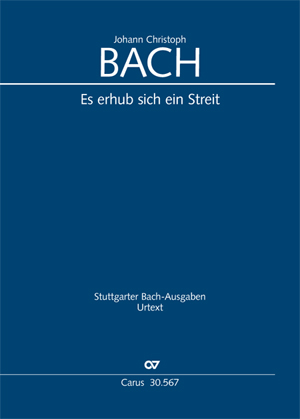
There arose then a war in heaven
Purchase
Additional product information
-
Composer
Johann Christoph Bach
| -1703Johann Christoph Bach (1642–1703), the eldest son of Heinrich Bach, was regarded in the family tradition as the greatest genius before Johann Sebastian; in the family chronicle he is described as the “great and expressive composer”. J.C. Bach was presumably taught by the Arnstadt cantor Jonas de Fletin, who as a pupil of Heinrich Schütz represented the ideal of a style of composition combining the Italian and German traditions. For more than twenty years J.C. Bach’s collaboration with his cousin Johann Ambrosius Bach proved to be particularly fruitful. The Eisenach Stadtchronik wrote of Johann Ambrosius that in 1672 he had “created an effect at Easter with organs, violins, singing, trumpets and timpani” such as no cantor had previously achieved, but this impression was also due in no small measure to the demanding and extremely profound compositions of Johann Christoph Bach. His creative output encompasses, in addition to various works for harpsichord and organ, above all, motets, choral arias and cantatas which are distinguished by a high degree of technical skill and an extraordinarily harmonically rich and varied tonal language. Personal details
-
Editor
Dietrich Krüger
Reviews
Hodie Christus natus est II
Die Michaeliskantate „Es erhub sich ein Streit” erfreute sich im 18. Jahrhundert einer ungewöhnlichen Beliebtheit. Sie berichtet vom Kampf des Erzengels Michael und seinen getreuen Anhängern mit dem Drachen, der aus dem Himmel vertrieben wird. Die Textgrundlage war für Kantatendichtungen eine wahre Fundgrube, da der Komponist so manche Anregung für die Vertonung bekam, u.a. den fast zwingenden Einsatz von Trompeten und Pauken.Im Eingangssatz „ Es erhub sich ein Streit” gelang es Bach eine seiner kunstvollsten Fugen zu schreiben. Ganz auffällig die Hypotyposis - Figuren in Verbindung mit der musikalischen Ausdeutung des Wortes „Streit”.
Ein vortreffliches Werk, das eher für leistungsstarke Chöre geeignet ist und auch liturgiefreundlich ist (18 Minuten Aufführungsdauer).
Peter Bartetzky
Quelle: Musik im Bistum Essen II/03 – I/04, S. 61
Frequent questions about this work
 There are no questions and answers available so far or you were unable to find an answer to your specific question about this work? Then click here and send your specific questions to our Customer Services!
There are no questions and answers available so far or you were unable to find an answer to your specific question about this work? Then click here and send your specific questions to our Customer Services!



